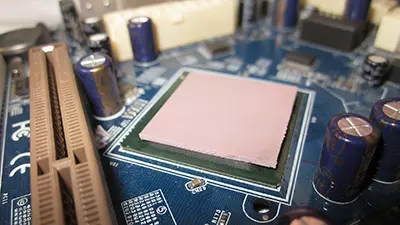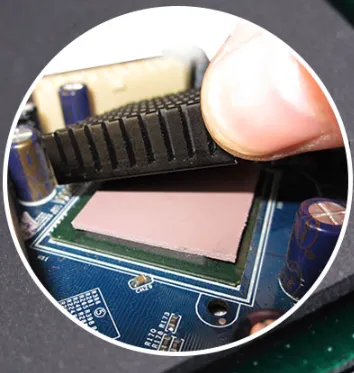What Is a Thermal Pad? Complete 2025 Guide to Materials, Thickness, Applications & How to Choose the Right One
A thermal pad—also known as a thermal interface pad (TIM pad)—is a soft, compressible material placed between a heat-generating component and a cooling device such as a heat sink, metal housing, or shielding case. Its primary function is to:- eliminate microscopic air gaps.
- increase effective contact area.
- improve heat transfer efficiency.
- ensure long-term thermal reliability.

As electronic devices become increasingly sophisticated and powerful, thermal pads have become indispensable thermal interface materials in consumer electronics, power modules, electric vehicle battery systems, automotive electronic control units, communication equipment, and industrial machinery.
This guide comprehensively explains the definition, operating principles, classification types, thickness requirements, performance specifications, engineering applications, and selection methods for thermal pads.
It also incorporates professional factory-level insights and optimized SEO structure to help engineers precisely locate the required solutions.
1. What is Thermal Pad?
A thermal pad is a soft, solid thermal interface material designed to sit between two surfaces to improve heat conduction. Unlike messy thermal paste, thermal pads are:- easy to apply
- gap-filling
- pressure-compliant
- electrically insulating
- stable over long-term operation
They are especially useful for uneven surfaces or where the gap between a device and a heat sink varies across a module.
- Softness: 20–70 Shore 00
- Thickness: 0.3mm–5.0mm
- Thermal Conductivity: 1–20 W/m·K
- Breakdown Voltage: up to 10kV
- Temperature Range: -40°C to 200°C
2. How Does a Thermal Pad Work?

Electronic components and heat sinks are not perfectly smooth. Their microscopic roughness traps air, which has extremely poor thermal conductivity (~0.026 W/m·K).
A thermal pad works by:
✔ Filling air gaps (micro + macro)
✔ Conforming to uneven surfaces
✔ Forming a continuous thermal path
✔ Reducing interface resistance
✔ Improving heat dissipation efficiency
This significantly reduces component temperature and enhances system stability and reliability.
3. Thermal Pad vs Thermal Paste
Below is a precise engineering comparison:|
Feature |
Thermal Pad |
Thermal Paste |
|
|
Form |
Solid / Soft |
Semi-liquid |
|
|
Gap Filling |
Excellent (0.3–5mm) |
Poor (<0.1mm) |
|
|
Electrical Insulation |
Yes |
Usually no |
|
|
Messiness |
Very clean |
Requires careful application |
|
|
Automation |
|
Difficult |
|
|
Long-Term Stability |
Very stable |
May dry or pump out |
|
|
Best For |
Modules, batteries, telecom, automotive |
CPUs, GPUs, flat interfaces |
Use thermal paste for ultra-flat surfaces.
Use thermal pads for any scenario where the surface is uneven or gap filling is needed.
4. Types of Thermal Pads
Typical Features of Thermal Pads
4.1 Silicone Thermal Pads (Most Popular)
- High softness
- Good compression
- Strong insulation
- Widely used in power modules, laptops, EVs
4.2 Non-Silicone Thermal Pads
- No silicone oil bleeding
- Essential for optics, displays, and silicone-sensitive components
4.3 Graphite Thermal Pads
- Extremely high thermal conductivity (up to 400 W/m·K in-plane)
- Thin & lightweight
- For smartphones, tablets, and compact systems
4.4 Phase Change Thermal Pads
- Solid at room temperature
- Softens or melts during heat
- Provides extremely low thermal resistance
4.5 Ultra-Soft Gel Pads
- Low hardness (10–20 Shore 00)
- Perfect for fragile chips, sensors, and ADAS modules
5. Recommended Thermal Pad Thickness
Choosing the correct thickness is vital.| Application | Recommended Thickness |
| CPUs & VRM Components | 0.3–1.0mm |
| Power Modules (IGBT/MOSFET) | 0.5–2.0mm |
| Automotive ECUs | 1–2.5mm |
| Telecom/5G Base Stations | 1–3mm |
| Battery Packs / EV Modules | 1–5mm |
| Industrial Control Systems | 0.5–2mm |
Choose the thinnest pad that fully fills the gap under compression.
Thicker pads create higher thermal resistance.
6. Performance Parameters Engineers Must Consider
1. Thermal Conductivity (W/m·K)High-performance applications require ≥10 W/m·K.
2. Compression & Hardness
Determines ability to fill gaps without stressing components.
3. Electrical Insulation
Critical for high-voltage power electronics.
4. Breakdown Voltage
Must match module safety requirements.
5. Temperature Resistance
Automotive and telecom devices require high thermal endurance.
6. Reliability & Aging
Durability under thermal cycling, humidity, vibration.
7. Where Are Thermal Pads Used?

Consumer Electronics
- Smartphones
- Laptops
- Gaming console
- SSDs
- Battery thermal management
- OBC (On-board chargers)
- ADAS module
- Motor controllers
- MOSFET
- IGBTs
- Power supply modules
- Base stations
- Network switches
- Remote radio units
- Imaging
- Monitoring equipment
8. How to Choose the Right Thermal Pad
When designing a thermal system, evaluate:- Gap distance (most important)
- Required thermal conductivity
- Component pressure and fragility
- Environmental conditions
- Insulation needs
- Regulatory compliance
9. SheenThermal Thermal Pad Solutions (Factory Supply)
SheenThermal is a professional manufacturer specializing in thermal interface materials. Our advantages include:- Thermal pads from 1–20 W/m·K
- Ultra-soft gel pads (10–20 Shore 00)
- High-voltage insulation pads
- Non-silicone pads for sensitive devices
- Customized sizes, thicknesses, and hardness
- Fast sampling & full technical support
- OEM / ODM production capability
- Consumer electronics
- Automotive electronics
- Power modules
- Telecom equipment
- Industrial devices
Our engineering team will reply within 12 hours.
10. Frequently Asked Questions (FAQ)
Q1. What is a thermal pad used for?It fills air gaps between components and heat sinks to improve heat transfer.
Q2. How long do thermal pads last?
Typically 5–10 years depending on material and usage conditions.
Q3. Should I choose thermal pad or thermal paste?
Pads for uneven or large gaps; paste for ultra-flat surfaces.
Q4. What thickness is best?
Use the minimum thickness that fills the gap under compression.
Q5. Do thermal pads insulate electricity?
Most silicone pads provide strong electrical insulation.

 English
English
 usheenthermal
usheenthermal



